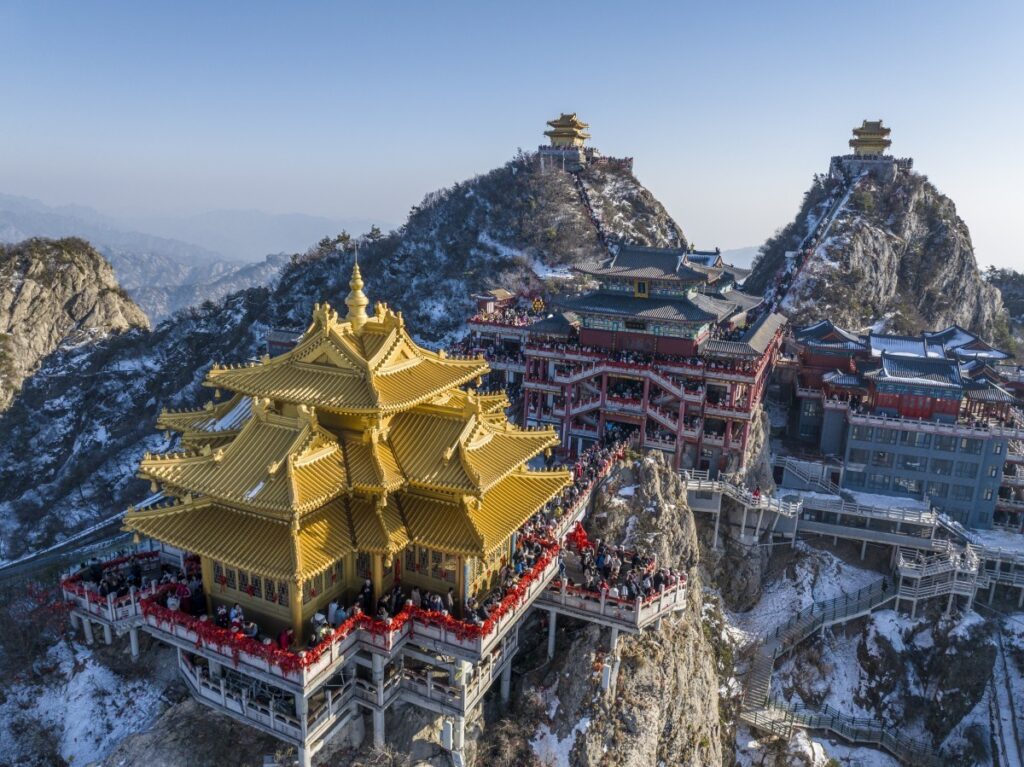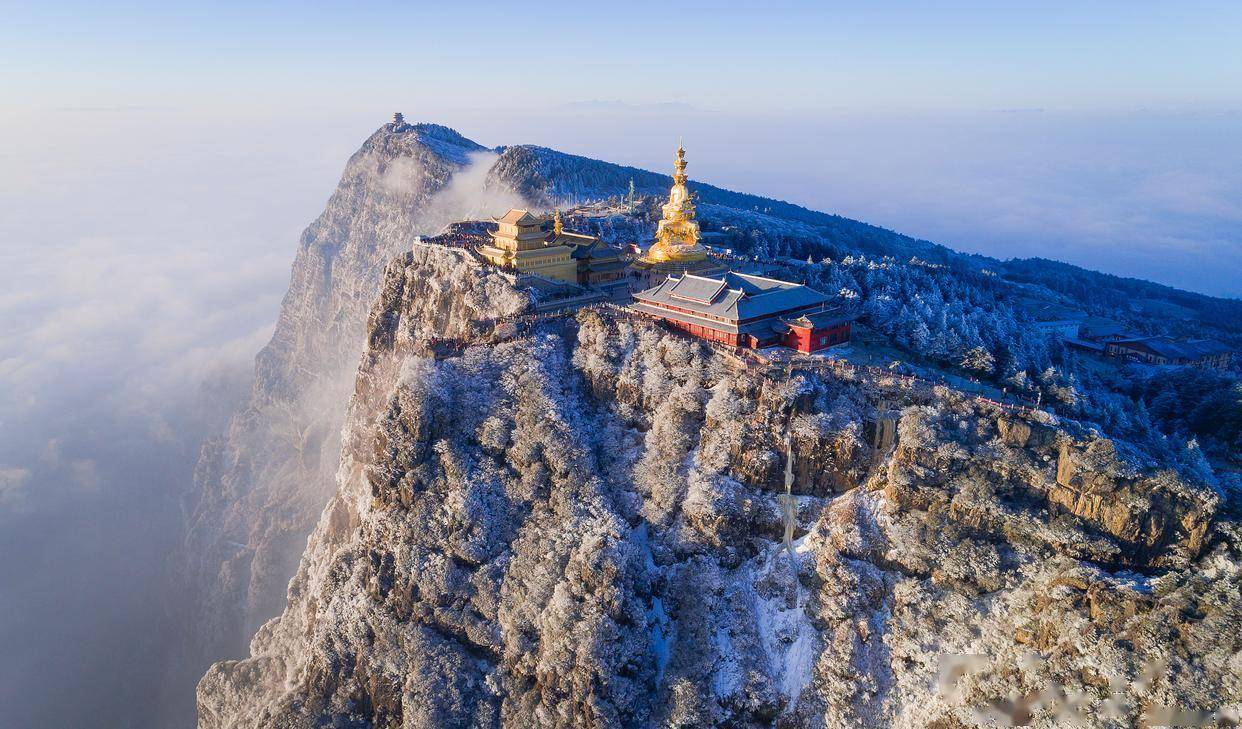Mount Emei, also known as “峨嵋山”, is an integral part of the Qionglai Mountain Range. It is located on the southwestern edge of the Sichuan Basin in China, stretching between 29°16′ – 29°43′ north latitude and 103°10′ – 103°37′ east longitude. Rising abruptly from the Emei Plain, the mountain extends in a north – south direction for a staggering 105 kilometers. The main peaks include Da’e Mountain, Er’e Mountain, San’e Mountain, and Si’e Mountain. Among them, Da’e Mountain forms the core of the Emei Mountain Scenic Area, covering an area of 154 square kilometers. The main peak, Jinding, and the highest peak, Wanfoding, stand at an elevation of 3099 meters.
Geological Marvels
Thanks to the Himalayan orogeny, the main body of Mount Emei was strongly uplifted along faults, giving rise to the magnificent mountain we see today. Geologically, the main body of Mount Emei is based on a north – south short anticline. In terms of geomorphology, it can be divided into erosional landforms (the Emei Mountain area) and depositional landforms (the Emei fan – shaped alluvial – proluvial plain) according to the way the landforms are shaped. By origin, it includes tectonic landforms, fluvial landforms, karst landforms, and glacial landforms. From the Emei Plain to the low – hilly areas below Wannian Temple, the soil is mainly purple soil and yellow clay. Affected by the monsoon circulation, areas above 2000 meters on Mount Emei are covered by ice and snow for about half a year. Here, there are no distinct four seasons, only a difference between winter and spring.
Natural Beauty
The Lush Forests
Mount Emei is cloaked in a vast expanse of lush forests. The lower slopes are dominated by broad – leaved forests, where a variety of trees such as camphor, bamboo, and magnolias thrive. As one ascends, coniferous forests gradually take over, with towering pines and firs. The air in the forest is refreshingly clean, filled with the sweet scent of plants. The forest not only provides a habitat for numerous wildlife species but also creates a serene and peaceful environment for visitors.
The Diverse Flora
The mountain is home to an incredibly diverse range of flora. There are over 3200 species of plants, making it a virtual botanical paradise. Among them are many rare and endemic species. The azaleas on Mount Emei are particularly famous. In spring, when they are in full bloom, the mountainsides are painted with a riot of colors, from delicate pinks to vibrant purples. The rhododendrons, with their large and showy flowers, add to the beauty of the landscape.
The Breathtaking Views
As you climb higher, the views become increasingly spectacular. From the summit, on a clear day, you can see as far as the horizon. The sea of clouds is a common sight, with white, fluffy clouds rolling and billowing below, giving the illusion of being in a fairyland. The sunrise and sunset views are equally stunning. The golden rays of the sun paint the sky and the mountains in warm hues, creating a magical and unforgettable scene.
The Waterfalls
Mount Emei also features several beautiful waterfalls. The Baishui Waterfall, for example, tumbles down from a great height, its water foaming and roaring. The sound of the waterfall can be heard from afar, adding to the vitality of the mountain. The water is crystal – clear, and in the sunlight, it sparkles like diamonds.
Rich Cultural Heritage
Mount Emei has a profound cultural heritage. Buddhism, Taoism, martial arts, and mountain – tea culture have all flourished here. Many historical figures have left behind poems extolling the beauty of the mountain. In 1996, the vast majority of cultural relics on Mount Emei were inscribed on the World Heritage List by UNESCO.
Buddhist Significance
Buddhism has a long – standing presence on Mount Emei. There are numerous temples and monasteries, such as the Leshan Giant Buddha Scenic Area which is closely related to Mount Emei. The temples are not only places of worship but also architectural masterpieces. The Golden Summit Temple, with its resplendent golden pagoda, is a symbol of the mountain’s Buddhist status. Monks and pilgrims from all over the world come here to pay their respects and seek spiritual enlightenment.
Taoist Influence
Taoism also has a long history on Mount Emei. The Taoist temples blend harmoniously with the natural environment, emphasizing the concept of living in harmony with nature. The Taoists here practice meditation and traditional Chinese medicine, and their way of life has had a profound impact on the local culture.
Martial Arts and Tea Culture
Mount Emei is also known for its unique martial arts. Emei martial arts have their own characteristics, combining strength and flexibility. The local people have passed down these martial arts skills from generation to generation. Additionally, the mountain – tea culture is thriving. The high – altitude environment provides ideal conditions for growing tea. The Emei tea, with its unique flavor and aroma, is highly regarded. Tea – making and tea – tasting are important parts of the local culture, and visitors can experience these traditions in local tea houses.
Tips for Visiting
If you plan to visit Mount Emei, here are some suggestions. First, wear comfortable hiking shoes as there will be a lot of walking. Second, bring appropriate clothing according to the season and altitude. It can be cold at higher altitudes, especially in winter. Third, plan your time in advance. You can choose to hike the entire mountain, which may take a few days, or take cable cars to some of the main attractions. Fourth, try the local food, such as the delicious Sichuan – style dishes and the famous Emei tea.
In conclusion, Mount Emei in Sichuan is a place that combines natural splendor with rich cultural heritage. Whether you are a nature lover, a history buff, or a seeker of spiritual peace, Mount Emei has something to offer. So, set out on this journey of discovery and let Mount Emei’s charm captivate you.

